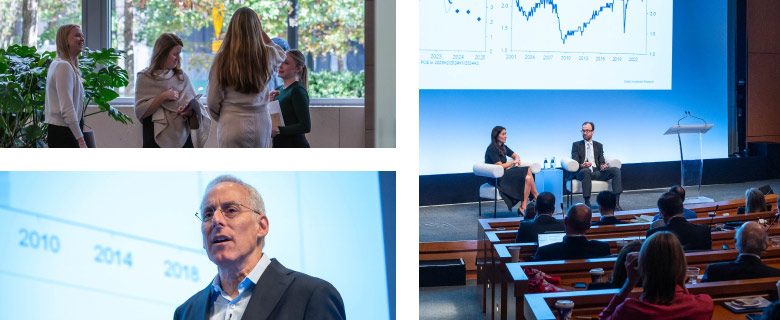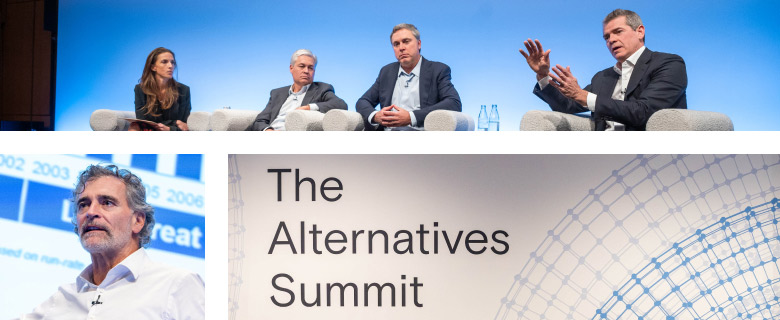Key Takeaways From The Alternatives Summit 2023
At the 22nd annual Alternatives Summit, we welcomed 430 clients alongside 40 leading investors and industry experts to explore ideas for how to adapt and grow within an ever-evolving investment landscape.

RETHINK
Many long-held assumptions about markets, geopolitics, and investing have been tested in recent years. Across strategies, the consensus is that the macro environment is more important than ever, but uncertainty remains the only constant. The outlook for rates was again in focus this year, but the question has shifted from “how high can they go?” to “how long will they stay here?” “This is causing a moment of reflection for GPs, as they consider what value creation going to be in the next ten years,” said Michael Brandmeyer, Global Co-Head & Co-CIO, External Investing Group (XIG) at Goldman Sachs Asset Management.
While it seems that a “soft landing” has been achieved for now, tightening financial conditions and exogenous factors continue to pose challenges. Geopolitical issues are increasingly forcing investors to consider factors far beyond traditional analyses, with a large election cycle in 2024 adding more ambiguity. "Companies want to have much more control over their business and not be so dependent on geopolitical trends,” asserted Lou D’Ambrosio, Global Head of the Goldman Sachs Value Accelerator.
As the market backdrop undergoes fundamental changes, investors are reconsidering how they build portfolios and manage liquidity. “We are now able to take building blocks of investment strategies, styles and factors that we’ve researched for the last 20 years and package them in a way that delivers the profile that clients tend to look for, but arguably in a more liquid, cost effective, and more transparent way,” says Osman Ali, Global Co-Head of Quantitative Investment Strategies at Goldman Sachs Asset Management.

REDOUBLE
With heightened market volatility and a higher cost of capital, the separation between winners and losers in the market has widened. During these periods of public market dislocations and re-ratings, active managers—which struggled amidst a prolonged period of low and falling rates—have more alpha potential. “Alpha is essentially skill multiplied by dispersion, and when you’ve had more inflationary periods, you have more volatility and dispersion,” according to Jack Springate, Co-Head, XIG Hedge Funds at Goldman Sachs Asset Management. Private markets, however, have been more insulated. “We’ve all lived dislocations, and this feels more like a relocation because of that starting point and the pace at which it moved,” observed Greg Olafson, President of Alternatives at Goldman Sachs Asset Management.
Amidst major structural changes, asset owners that were prudent in the past will be best positioned to capitalize on opportunities in the present. Dealmaking has slowed considerably, and more attention is being paid to fortifying current holdings and driving value through fundamentals. “Existing investors are doubling down on good quality companies in their portfolio,” said Stephanie Hui, Global Co-Head of Private & Growth Equity at Goldman Sachs Asset Management. With tighter financial conditions, asset owners are forging deeper ties with existing lenders as well. "The power of being at scale and having incumbency provides the ability to ‘shop in your own closet,’ which is really powerful,” Stephanie Rader, Global Head of Private Credit Client Solutions & Product Strategy at Goldman Sachs Asset Management.
Value creation has come to the forefront, but these initiatives take time, and many investors today need liquidity. “This is leading to a desire for creative solutions that avoid refinancing the existing capital structure while providing some liquidity,” said Harold Hope, Head of Secondaries Investing at Goldman Sachs Asset management.

REIMAGINE
The pace of change has accelerated across many facets of life and is unlikely to reverse. The advent of AI holds the promise of productivity increases alongside reductions in low-value work—but it also presents challenges in preparing businesses and people for new realities. Addressing areas like IT services in particular, Michael Bruun, Global Co-Head of Private Equity at Goldman Sachs Asset Management, noted “If a CEO is not thinking through what generative AI is going to do though that person’s business, then that person is probably not the right partner for us.”
Sustainability remains top of mind for a multitude of reasons, particularly for real assets where resource requirements are often most intense. “The real estate industry is a significant contributor to carbon emissions, therefore we believe property can play a critical role in meeting climate goals around the world,” said Jim Garman, Global Head, Real Estate at Goldman Sachs Asset Management. But it will take time for the transition to play out. “Even though people may like it to go quickly, there are physical constraints that it will make it take longer than they would like,” said Ken Pontarelli, Global Head of Private Markets Sustainable Investing at Goldman Sachs Asset Management.
“We need to be students of markets, thinking about the way in which all of these new drivers are going to impact real estate needs going forward—not just in the traditional places where we’ve invested historically but in new places where there is currently a land grab,” said Jeffrey Fine, Global Head of Real Estate Client Solutions at Goldman Sachs Asset Management. As investors look ahead, however, it’s important to not lose sight of the present—a balance is needed between long-term strategic oversight and executing on day-to-day operations.